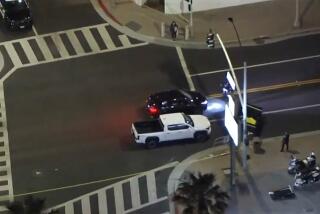44 years later, New York police find driver who killed girl
- Share via
Police in upstate New York have solved a 44-year-old hit-and-run that left a 4-year-old girl dead, but the driver who fled on Halloween night in 1968 won’t be charged because the statute of limitations has expired.
The driver is a man who still lives in the area, and who confessed after a Facebook posting by a retired police officer prompted someone to come forward with information. That information pointed to Douglas Parkhurst, police in Fulton, N.Y., said in a news release Wednesday. Fulton is about 280 miles north of New York City.
In a telephone interview with the Los Angeles Times, Fulton police Sgt. Stephen Lunn Jr. said Parkhurst had provided a written statement last week admitting his guilt in Carolee Ashby’s death and asking the girl’s family to forgive him.
“You could see he was remorseful,” Lunn said. “He did give a written statement apologizing and begging for forgiveness.”
Parkhurst had been on police officers’ radar from the start because he drove the same kind of car -- a tan 1962 Buick Special -- that had killed Carolee as she crossed a street with her older sister, Darlene, who survived. The girls were out buying candles for a birthday cake for Darlene, who turned 15 that day: Oct. 31, 1968.
In the days after the incident, police spoke with Parkhurst, who was a teenager at the time. He admitted he had been in an accident that night. But Parkhurst said that his crash was in another town and that he had hit a guardrail. Police weren’t convinced he was telling the truth, but they did not interview him further and the case went cold.
Efforts to generate new leads in 2000 failed to give police the information they needed. But in March 2012, a retired Fulton police lieutenant, Russ Johnson, posted a message on Facebook asking for help in solving the case.
“The family has forever been tormented by this,” Johnson wrote, describing how Carolee was “ripped out of her sister’s hand” as they walked together. “Although I am retired, my heart is still with the Ashby family and this case.”
Eventually, a woman living in Florida whom police did not identify came forward. She told police that in 1968, she had been asked to provide an alibi for Douglas Parkhurst for the night of the hit-and-run. The woman refused to do so and was never told why Parkhurst needed an alibi, but she assumed it had something to do with Carolee’s death, according to police.
Lunn said officers visited Parkhurst several times before he confessed last week. “I think there probably was a little feeling of surprise that we were there,” 44 years after the fact, Lunn said.
Parkhurst eventually told police that he had consumed alcohol that night and was driving through Fulton when he hit something. He thought it was an animal and kept going, but he came to realize he had hit the little girl. Parkhurst also told police he had lied to officers in 1968 when he claimed to have been in another city the night Carolee was killed.
Carolee’s sister, Darlene Ashby McCann, said last year after Johnson revived interest in the case that the family only wanted an apology. “My mom lives in pain every day wishing that this case would be solved,” McCann said, noting that Carolee’s father and brother had died without knowing who killed her. Hearing someone say they were sorry for running down Carolee is “not ... much to ask,” McCann said at the time.
On Wednesday, McCann posted a message on Facebook saying that although the Fulton police had “botched” the investigation into her sister’s death in 1968, she was grateful for the “great effort” that Johnson and the current officers had made to solve the case.
Police say the only way Parkhurst could have been charged after 44 years was if it could be proved that he had intentionally hit Carolee, because there is no statute of limitations on murder.
But Lunn said prosecuting someone was not the primary goal after all this time, and that officers knew going into it that the statute of limitations had expired long ago.
“Our goal was to bring some closure to the family, or any type of relief to the family that we could by locating and identifying the person responsible,” said Lunn, adding that officers too young to remember the incident were still troubled by it.
“This case really hit home because it was a 4-year-old who was killed,” he said.
tina.susman@latimes.com
ALSO:
House votes to honor victims of 1963 church bombing
Rhode Island set to become 10th state to legalize gay marriage
Boston bombing: Details of suspect’s fight with girlfriend emerge
More to Read
Sign up for Essential California
The most important California stories and recommendations in your inbox every morning.
You may occasionally receive promotional content from the Los Angeles Times.














